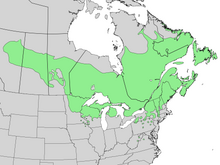Balsam fir
| Balsam fir | |
|---|---|
 |
|
| Tree with cones | |
| Scientific classification | |
| Kingdom: | Plantae |
| Division: | Pinophyta |
| Class: | Pinopsida |
| Order: | Pinales |
| Family: | Pinaceae |
| Genus: | Abies |
| Species: | A. balsamea |
| Binomial name | |
|
Abies balsamea (L.) Mill. |
|
 |
|
| Range | |
| Synonyms | |
|
|
Abies balsamea or balsam fir is a North American fir, native to most of eastern and central Canada (Newfoundland west to central British Columbia) and the northeastern United States (Minnesota east to Maine, and south in the Appalachian Mountains to West Virginia).
Balsam fir is a small to medium-size evergreen tree typically 14–20 metres (46–66 ft) tall, rarely to 27 metres (89 ft) tall, with a narrow conic crown. The bark on young trees is smooth, grey, and with resin blisters (which tend to spray when ruptured), becoming rough and fissured or scaly on old trees. The leaves are flat and needle-like, 15 to 30 mm (5⁄8 to 1 1⁄8 in) long, dark green above often with a small patch of stomata near the tip, and two white stomatal bands below, and a slightly notched tip. They are arranged spirally on the shoot, but with the leaf bases twisted so that the leaves appear to be in two more-or-less horizontal rows on either side of the shoot. The seed cones are erect, 40 to 80 mm (1 1⁄2 to 3 1⁄4 in) long, dark purple, ripening brown and disintegrating to release the winged seeds in September.
Bark
Leaves (needles) on symmetrical branchlets
Closeup of thickly leaved branchlets
Pollen cones
Seed cones with resin oozing out in the Mingan Archipelago, Quebec
There are two varieties:
On mountain tops, stands of balsam fir occasionally develop fir waves. Often found in association with black spruce, white spruce and trembling aspen.
...
Wikipedia

